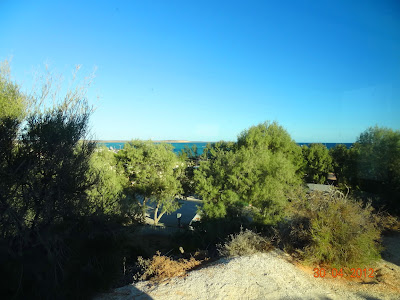This tiny little town has so much history...
Denham is the main town in the Shark Bay World Heritage area. Shark Bay received World Heritage listing in 1991 and is one of only a handful of places in the world that satisfy all four criteria for a heritage listing; having an important evolutionary and biological history, unique formations and natural habitats where threatened species survive.
It has spectacular coastal scenery includes the Zuytdorp cliffs, Shell Beach, Cape Peron and unique natural phenomena such as the stromatolites and the Wooramel sea grass bank. Shark Bay has 13 threatened reptile species, three rare bird species, a population of over ten thousand dugongs and significant loggerhead turtle rockeries.
The Hamelin Pool stromatolites are part of the Earth's evolutionary history with the living microbes building these stromatolites being similar to those found in 3,500 million-year-old rocks which are the earliest record of life on earth.
For those of you that are interested in what stromatolites are please read on...otherwise scroll on...
A stromatolite (literally, ‘layered rock’) is a solid structure created by single-celled microbes called cyanobacteria (blue-green algae). The cyanobacteria form colonies and trap sediment with their sticky surface coatings. The trapped sediment reacts to calcium carbonate in the water to form limestone. These limestone deposits build up very slowly – it can take a stromatolite 100 years to grow 5 cm. A 1 m-high stromatolite might be 2,000 years old
Shark Bay’s stromatolites are found around the shallows of Hamelin Pool , located in the southern part of the eastern bay. Between 4,000 to 6,000 years ago a massive seagrass bank called the Fauré Sill began to block tidal flow into Hamelin Pool, causing the water to become extremely concentrated, or hypersaline. The water in Hamelin Pool is twice as salty as water in the open ocean! Animals that would normally graze on algae, such as chitons and snails, cannot survive in these conditions. Around 3,000 years ago cyanobacteria started flourishing, forming stromatolites much as they did billions of years ago. More than 50 species of cyanobacteria live in Hamelin Pool.
Stromatolites look a cross between a cauliflower and a rock. However, unlike rocks they are actually alive – each stromatolite has a top surface layer teeming with living, active cyanobacteria. At least 3,000 million cyanobacteria can fit in 1 m2! Because cyanobacteria are plants, they photosynthesise their energy from the sun. A by-product of photosynthesis is oxygen, and if you look very carefully you may see the stromatolites gently ‘fizzing’ as tiny bubbles of oxygen are released by the cyanobacteria into the water.
The size and shape of stromatolites are thought to be influenced by their immediate environment. Large mushroom-shaped stromatolites may form in places where tides and small waves approach from different directions. Loaf-shaped stromatolites are found in protected areas close to the shore. Because cyanobacteria need sunlight to photosynthesise, the stromatolites in Hamelin Pool do not form in water deeper than 4 m, where there is less light.
Such an amazing place... As you drive into town..there are only a handful of little shops...and the whole frontage of the main street (only one main street) is water frontage..crystal clear and once again boats everywhere...
The caravan park where we are staying is built on 3 levels on the side of a hill, so that there is a view of the water from all the front spots... and everyone gets to enjoy it..including us..
View from our windows
The ground was covered in crushed shells...and John had to borrow a drill bit from reception to drill down into the hard ground to get the pegs in...and even then it was still hard to knock them in..
Once we had settled in we realised we were parked next to friends we met in Cervantes ...Peter & Bernadette.... it's amazing how many times you bump into the same people on the road...But it was a nice park...
Footnote: All my scans and xrays and blood tests came back normal.. so it's still a mystery



.jpg)









No comments:
Post a Comment